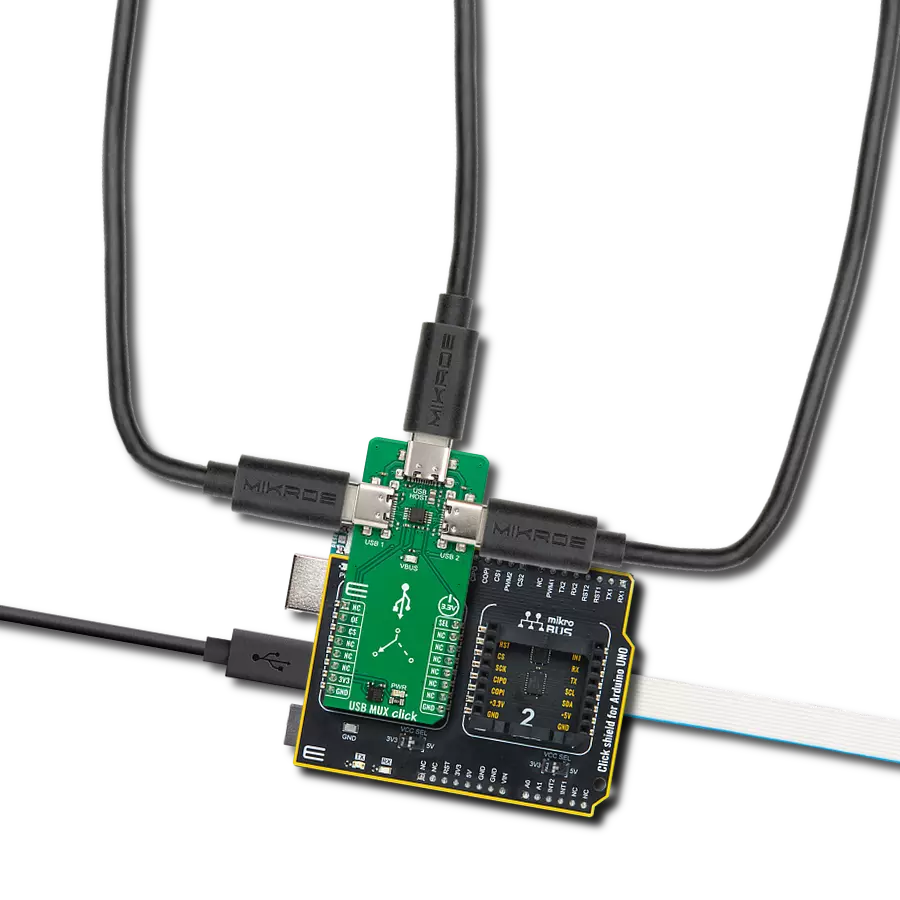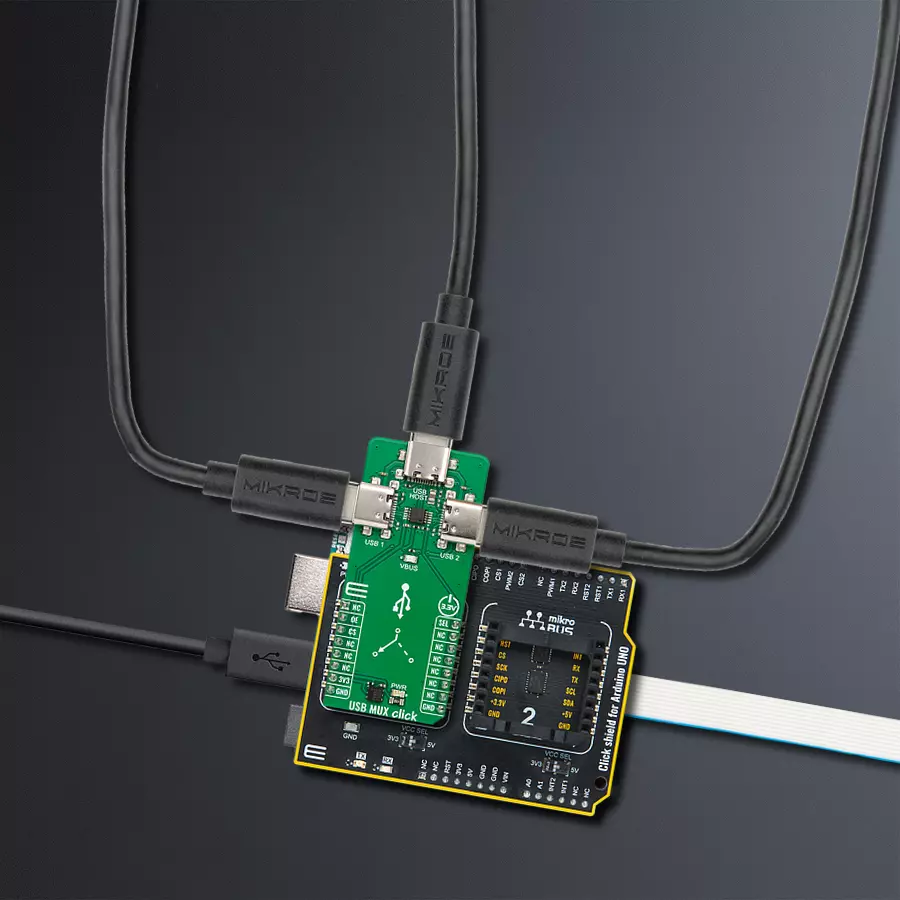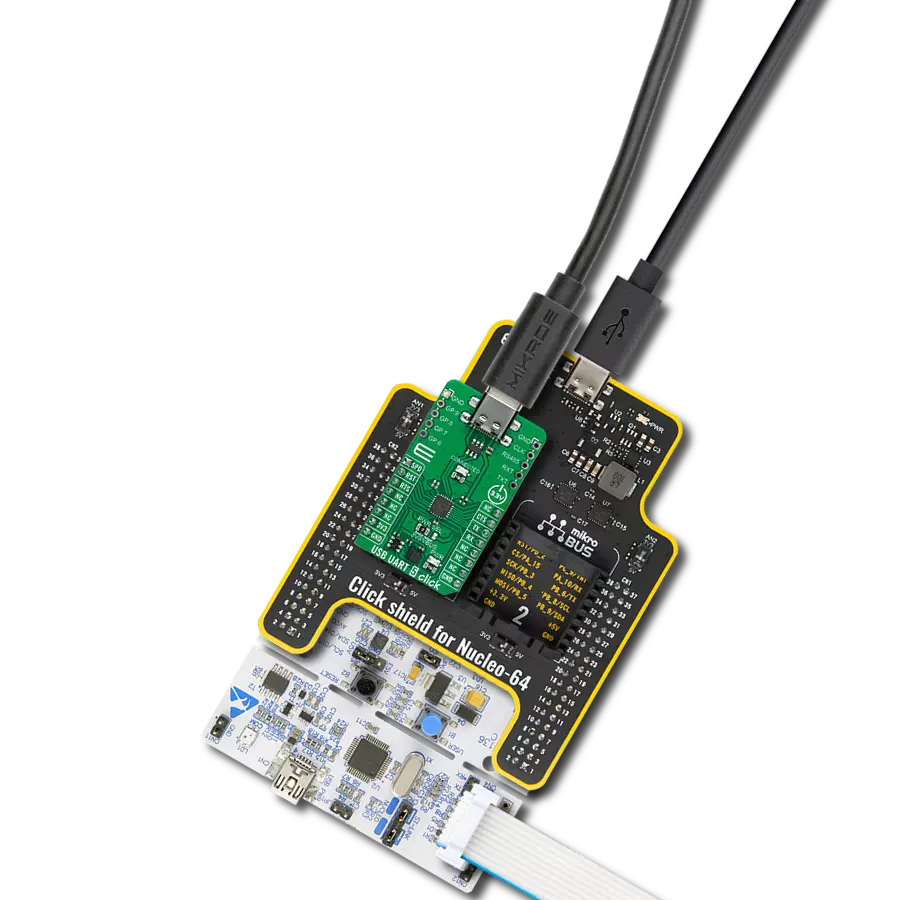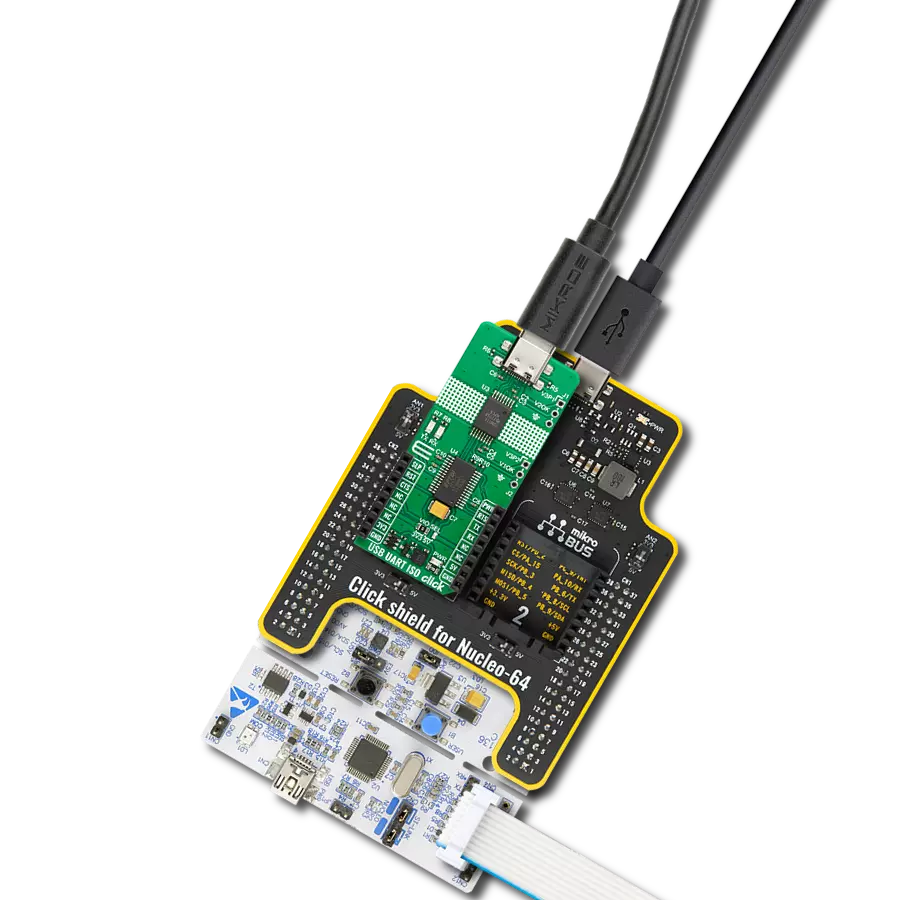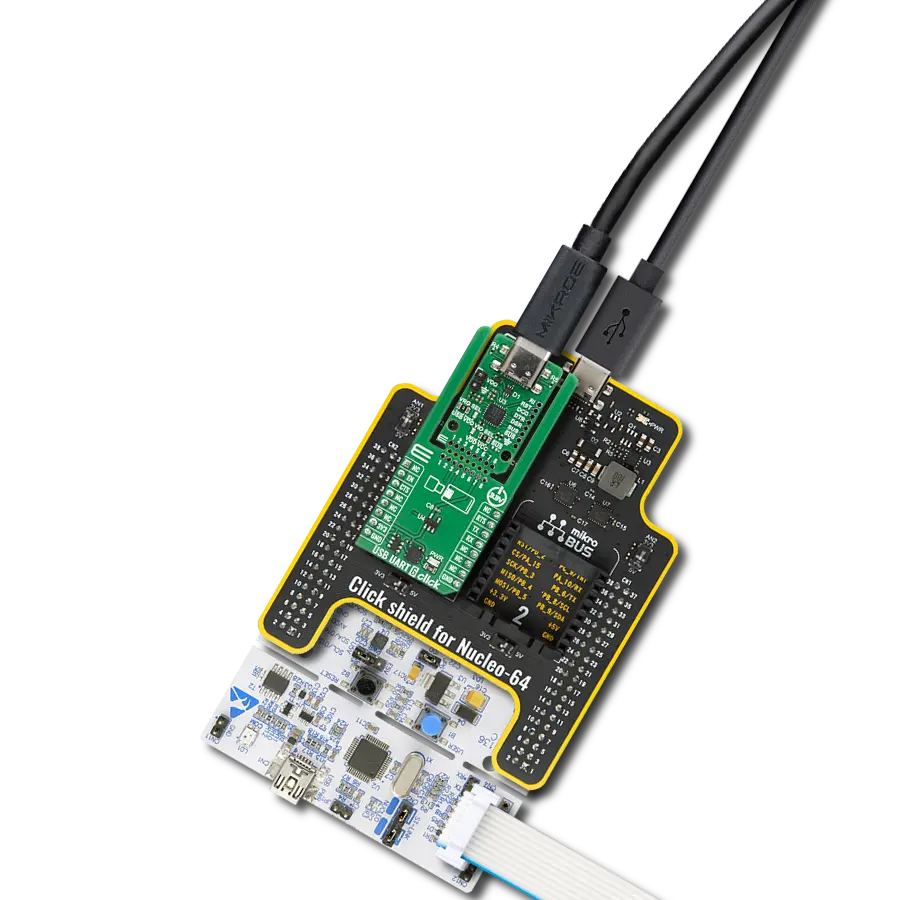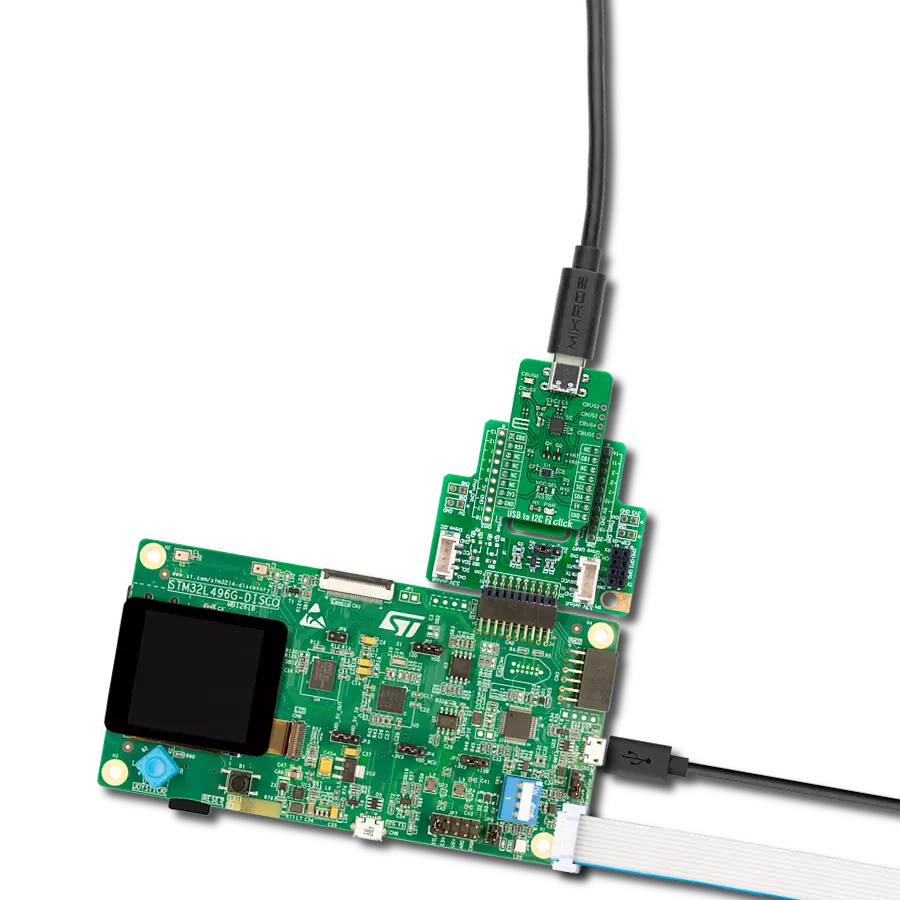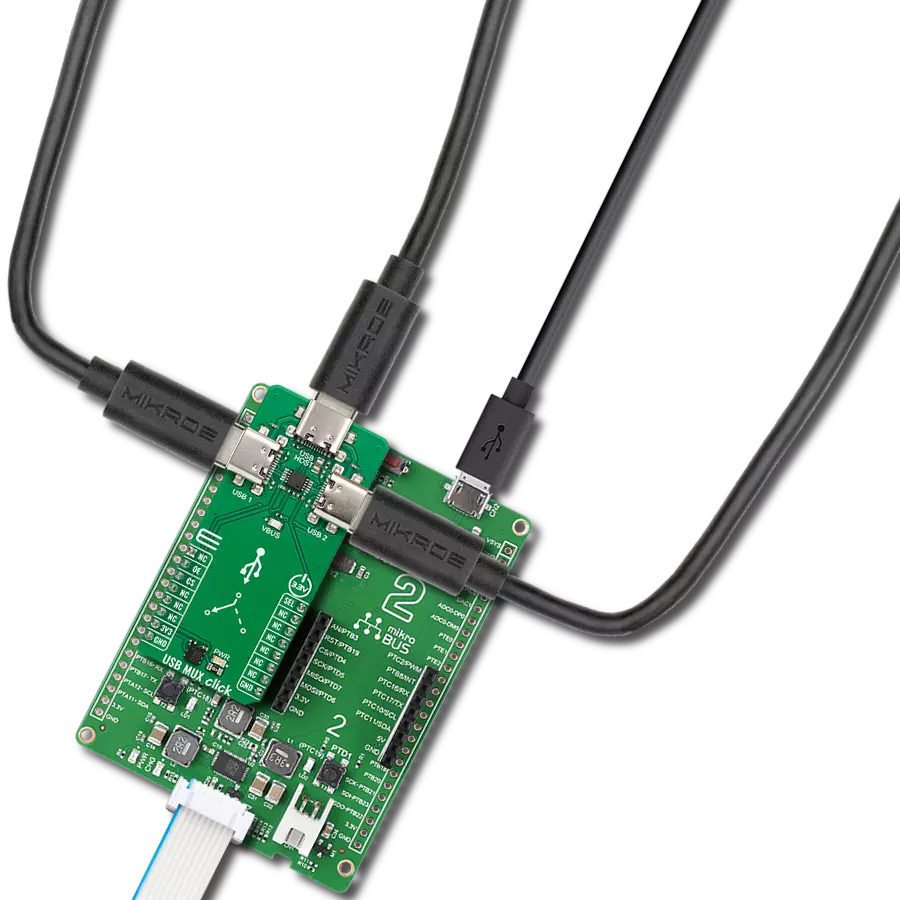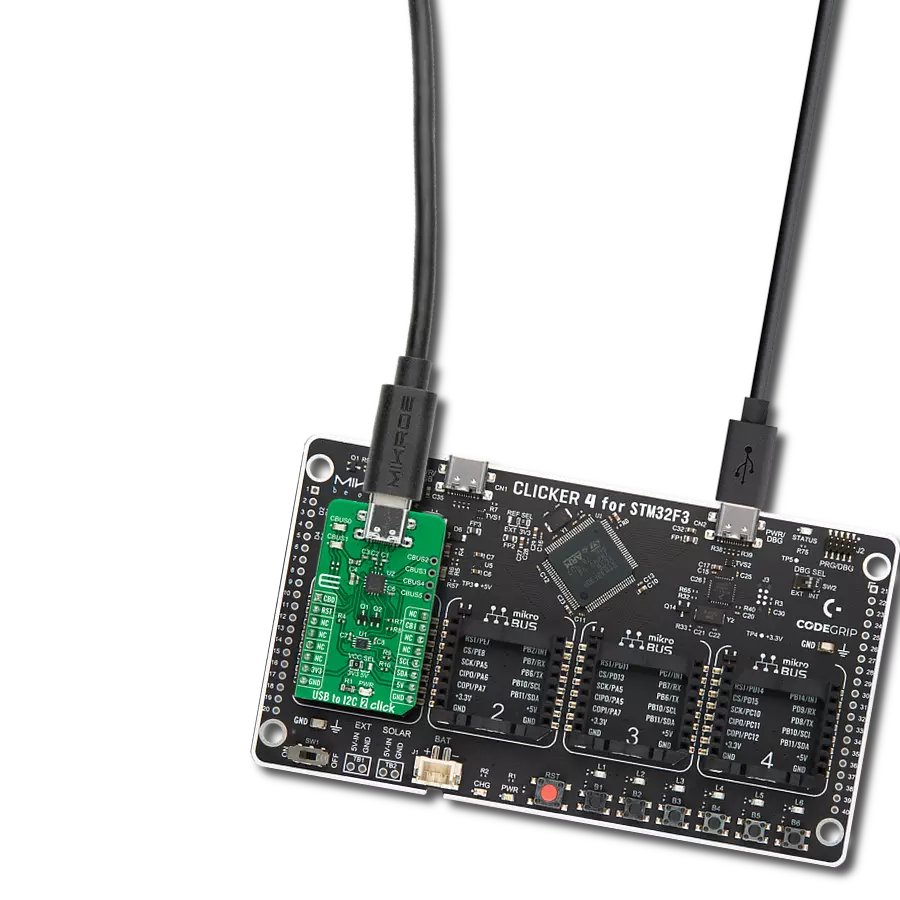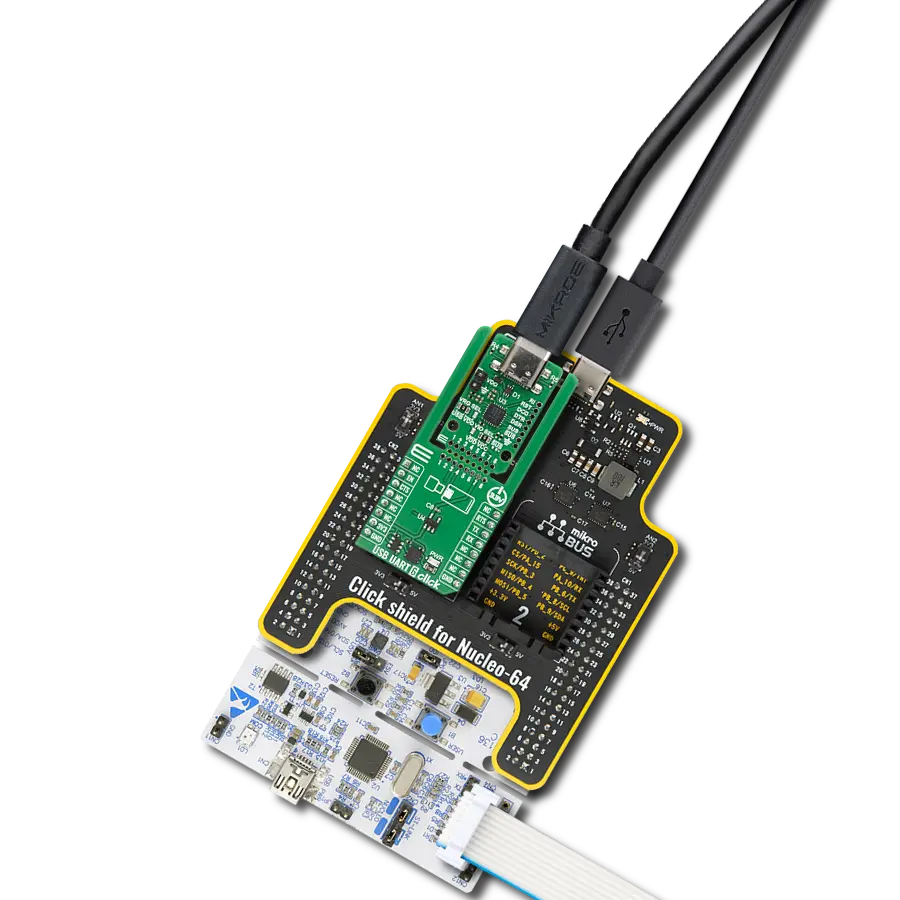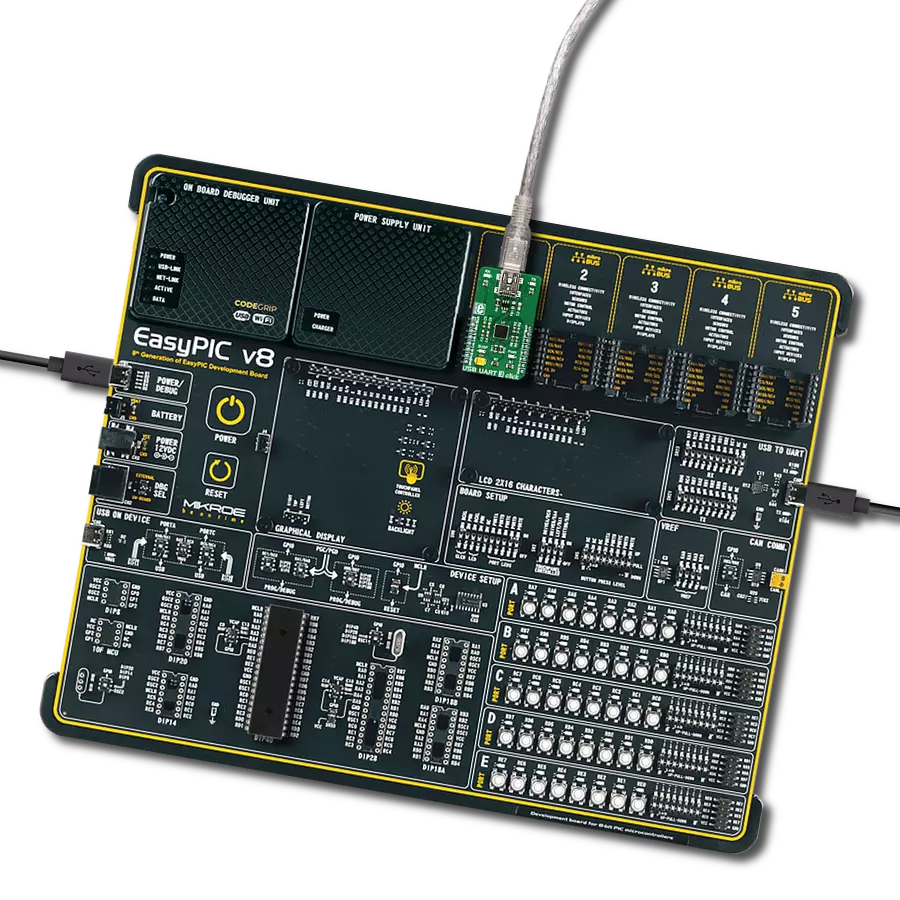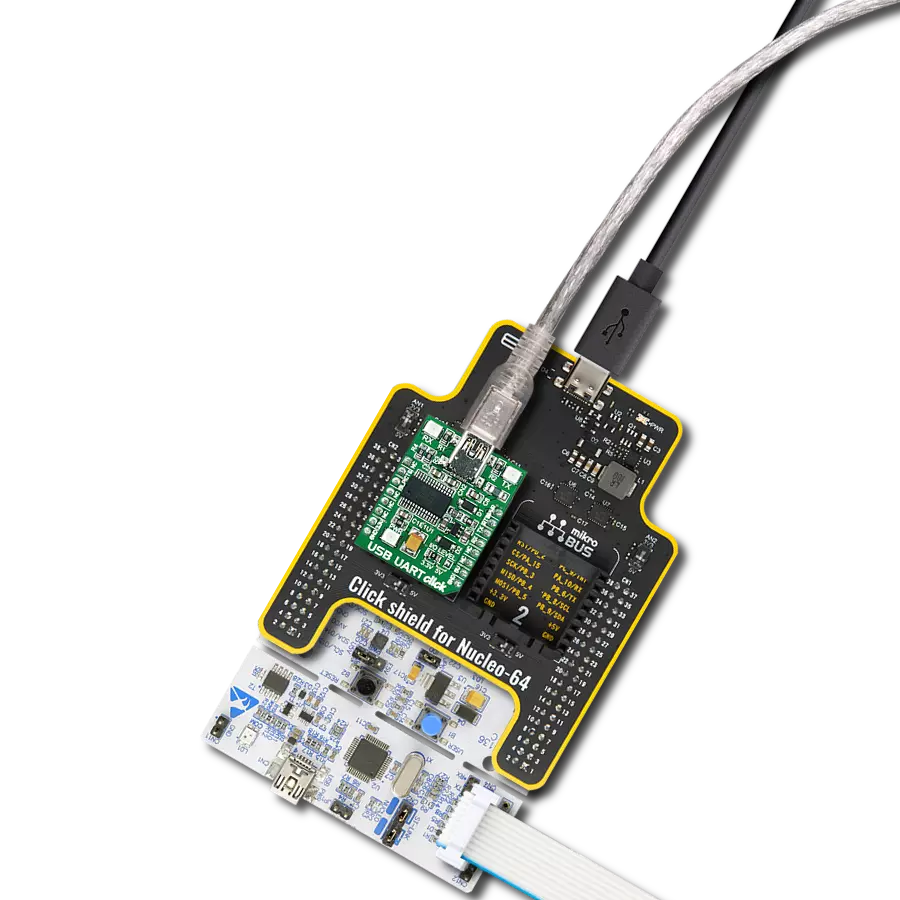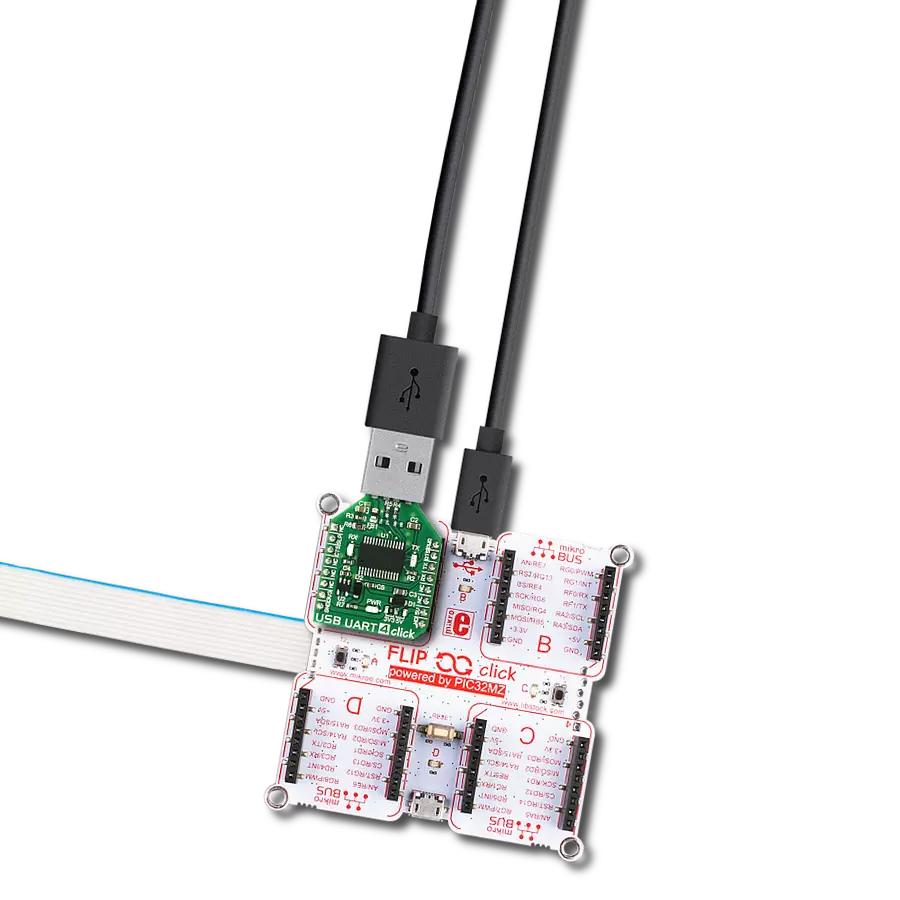Multiplexing differential outputs has never been easier – choose between two corresponding outputs from a USB host or effortlessly merge outputs from two different hosts for enhanced versatility.
A
A
Hardware Overview
How does it work?
USB MUX Click is based on the TS3USB30E, a USB 2.0 1:2 multiplexer/demultiplexer switch with a single enable from Texas Instruments. It is an ESD-protected device capable of bidirectional switching of high-speed USB 2.0 signals while offering little or no attenuation of the high-speed signals at the outputs. Besides the ESD protection, the TS3USB30E offers a low bit-to-bit skew and high channel-to-channel noise isolation. Also, besides USB 2.0, it is compatible with USB 1.1 standard. The maximum speed the TS3USB30E is
capable of is 480Mbps at USB 2.0. USB MUX Click communicates with the host MCU using a few GPIOs. The OE bus-switch enable pin allows users to isolate the bus when not in use and consume less current. With a LOW logic level set on the OE pin, you can use it in combination with the SEL pin to select one of two USB signal paths and connect it to a common USB signal path, with a LOW logic level to a USB1 and a HIGH logic level to a USB2. The USB1 is set by default over the pull-down resistors R5 and R6, which puts both OE and SEL
lines in a low logic state. In addition, the VBUS LED will indicate if the powered USB device is connected to the USB MUX Click. This Click board™ can only be operated with a 3.3V logic voltage level. The board must perform appropriate logic voltage level conversion before using MCUs with different logic levels. Also, this Click board™ comes equipped with a library containing easy-to-use functions and an example code that can be used as a reference for further development.
Features overview
Development board
Arduino UNO is a versatile microcontroller board built around the ATmega328P chip. It offers extensive connectivity options for various projects, featuring 14 digital input/output pins, six of which are PWM-capable, along with six analog inputs. Its core components include a 16MHz ceramic resonator, a USB connection, a power jack, an
ICSP header, and a reset button, providing everything necessary to power and program the board. The Uno is ready to go, whether connected to a computer via USB or powered by an AC-to-DC adapter or battery. As the first USB Arduino board, it serves as the benchmark for the Arduino platform, with "Uno" symbolizing its status as the
first in a series. This name choice, meaning "one" in Italian, commemorates the launch of Arduino Software (IDE) 1.0. Initially introduced alongside version 1.0 of the Arduino Software (IDE), the Uno has since become the foundational model for subsequent Arduino releases, embodying the platform's evolution.
Microcontroller Overview
MCU Card / MCU
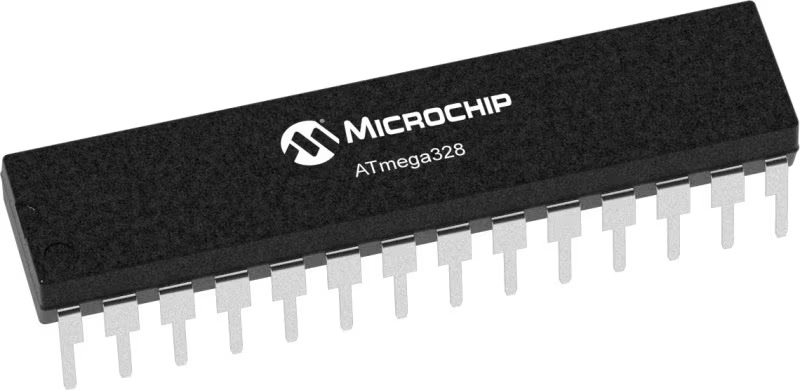
Architecture
AVR
MCU Memory (KB)
32
Silicon Vendor
Microchip
Pin count
32
RAM (Bytes)
2048
You complete me!
Accessories
Click Shield for Arduino UNO has two proprietary mikroBUS™ sockets, allowing all the Click board™ devices to be interfaced with the Arduino UNO board without effort. The Arduino Uno, a microcontroller board based on the ATmega328P, provides an affordable and flexible way for users to try out new concepts and build prototypes with the ATmega328P microcontroller from various combinations of performance, power consumption, and features. The Arduino Uno has 14 digital input/output pins (of which six can be used as PWM outputs), six analog inputs, a 16 MHz ceramic resonator (CSTCE16M0V53-R0), a USB connection, a power jack, an ICSP header, and reset button. Most of the ATmega328P microcontroller pins are brought to the IO pins on the left and right edge of the board, which are then connected to two existing mikroBUS™ sockets. This Click Shield also has several switches that perform functions such as selecting the logic levels of analog signals on mikroBUS™ sockets and selecting logic voltage levels of the mikroBUS™ sockets themselves. Besides, the user is offered the possibility of using any Click board™ with the help of existing bidirectional level-shifting voltage translators, regardless of whether the Click board™ operates at a 3.3V or 5V logic voltage level. Once you connect the Arduino UNO board with our Click Shield for Arduino UNO, you can access hundreds of Click boards™, working with 3.3V or 5V logic voltage levels.
Used MCU Pins
mikroBUS™ mapper
Take a closer look
Click board™ Schematic
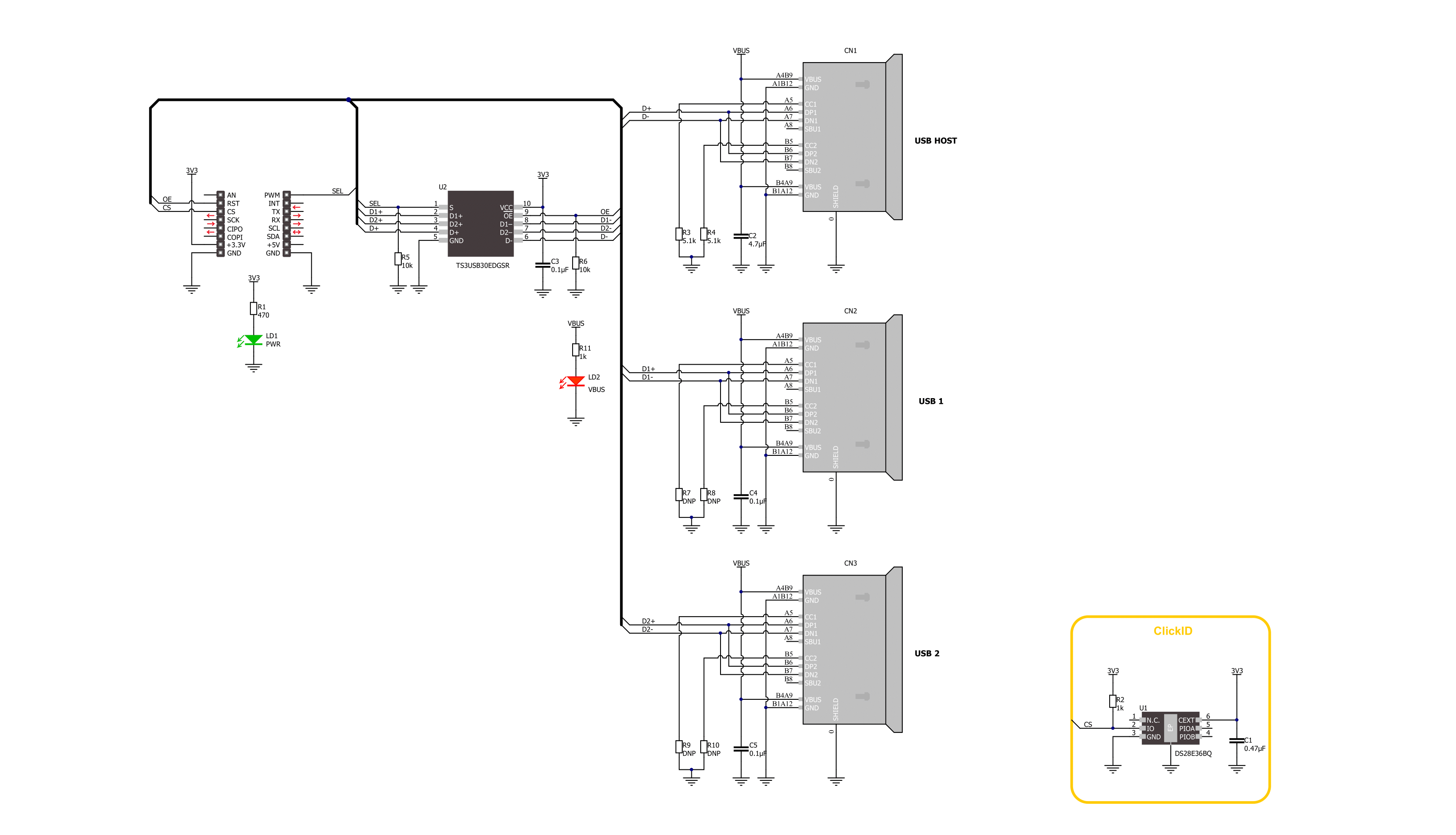
Step by step
Project assembly
Software Support
Library Description
This library contains API for USB MUX Click driver.
Key functions:
usbmux_set_oe_pin- USB MUX set OE pin output function.usbmux_enable_output- USB MUX enable output function.usbmux_set_output- USB MUX select output function.
Open Source
Code example
The complete application code and a ready-to-use project are available through the NECTO Studio Package Manager for direct installation in the NECTO Studio. The application code can also be found on the MIKROE GitHub account.
/*!
* @file main.c
* @brief USB MUX Click Example.
*
* # Description
* This example demonstrates the use of the USB MUX Click board.
* This driver provides functions for device configurations
* and for the selection of the output.
*
* The demo application is composed of two sections :
*
* ## Application Init
* Initialization of the log UART, performing default configuration which disables the output.
*
* ## Application Task
* Reading user input from UART Terminal and using it for the selection of the output of
* disabling output of the USB MUX Click board.
*
* @author Stefan Ilic
*
*/
#include "board.h"
#include "log.h"
#include "usbmux.h"
static usbmux_t usbmux; /**< USB MUX Click driver object. */
static log_t logger; /**< Logger object. */
/**
* @brief Display possible selection function.
* @details This function is used to display possible selections for the user input.
* @return Nothing.
* @note None.
*/
static void display_selection ( void );
void application_init ( void )
{
log_cfg_t log_cfg; /**< Logger config object. */
usbmux_cfg_t usbmux_cfg; /**< Click config object. */
/**
* Logger initialization.
* Default baud rate: 115200
* Default log level: LOG_LEVEL_DEBUG
* @note If USB_UART_RX and USB_UART_TX
* are defined as HAL_PIN_NC, you will
* need to define them manually for log to work.
* See @b LOG_MAP_USB_UART macro definition for detailed explanation.
*/
LOG_MAP_USB_UART( log_cfg );
log_init( &logger, &log_cfg );
log_info( &logger, " Application Init " );
// Click initialization.
usbmux_cfg_setup( &usbmux_cfg );
USBMUX_MAP_MIKROBUS( usbmux_cfg, MIKROBUS_1 );
if ( DIGITAL_OUT_UNSUPPORTED_PIN == usbmux_init( &usbmux, &usbmux_cfg ) )
{
log_error( &logger, " Communication init." );
for ( ; ; );
}
usbmux_default_cfg( &usbmux );
log_info( &logger, " Application Task " );
display_selection( );
}
void application_task ( void )
{
static char index;
if ( 1 == log_read( &logger, &index, 1 ) )
{
switch ( index )
{
case ( '0' ):
{
log_printf( &logger, " Turning output off. \r\n" );
usbmux_disable_output( &usbmux );
break;
}
case ( '1' ):
{
log_printf( &logger, " USB1 Enabled and selected. \r\n" );
usbmux_set_output( &usbmux, USBMUX_USB1_SELECT );
usbmux_enable_output( &usbmux );
break;
}
case ( '2' ):
{
log_printf( &logger, " USB2 Enabled and selected. \r\n" );
usbmux_set_output( &usbmux, USBMUX_USB2_SELECT );
usbmux_enable_output( &usbmux );
break;
}
default:
{
display_selection( );
}
}
}
}
int main ( void )
{
/* Do not remove this line or clock might not be set correctly. */
#ifdef PREINIT_SUPPORTED
preinit();
#endif
application_init( );
for ( ; ; )
{
application_task( );
}
return 0;
}
static void display_selection ( void )
{
log_printf( &logger, " To select USB output settings \r\n" );
log_printf( &logger, " Send one of the numbers: \r\n" );
log_printf( &logger, "- - - - - - - - - - - - - -\r\n" );
log_printf( &logger, " '0' - Turn off output \r\n" );
log_printf( &logger, " '1' - Enable and select USB1 \r\n" );
log_printf( &logger, " '2' - Enable and select USB2 \r\n" );
log_printf( &logger, "---------------------------\r\n" );
}
// ------------------------------------------------------------------------ END
Additional Support
Resources
Category:USB
